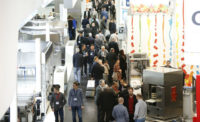Reported by Kris Collins, Publisher
Written and edited by Bernard Pacyniak, Editor-in-Chief
Less than 1,050 days away. Although hard to believe, the planning — albeit in its most preliminary stages — has already begun for interpack 2017. Given the results from this year’s triennial processing and packaging show, the expectations will be high.
After all, there were 175,000 visitors to this year’s show, which spanned 19 halls and included nearly 2,700 exhibitors. By all accounts, attendees and exhibitors were pleased, even to the point of signing contracts at the show, something that doesn’t occur that often anymore.
As Friedbert Klefenz, president of the interpack Exhibitors’ Advisory Board 2014 and president of Bosch Packaging Technology, says: “We are very satisfied with the quantity and quality of visitors at our stand. The interest taken in our technologies that make a vital contribution to global health and nutrition was enormous.
“We are pleased with the high number of leads produced, including many top executives and potential new customers,” he adds. “Similar comments came from other exhibitors. We were equally thrilled by the high number of international visitors and exhibitors – some 75% of the exhibiting enterprises were headquartered outside Germany. With this, interpack has confirmed its reputation as the world’s leading trade fair for the packaging sector.”
It’s important to expand that statement by ascertaining interpack’s value as the world’s leading trade fair for the confectionery processing and packaging sectors. As the following vignettes attest, there were plenty of innovations and improvements from cocoa, chocolate and candy processing equipment suppliers to confectionery primary and secondary packaging companies.
In general, one could paraphrase the Olympic motto, “Faster, Higher, Stronger,” into a confectionery suppliers clone, “Faster, Easier, Cleaner.”
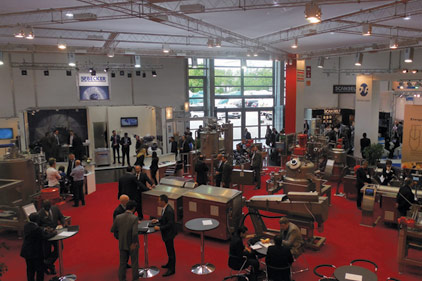
|
For example, at Hansel Processing’s booth, the company exhibited its Sucroliner 1712 hard candy line, which is capable of putting out 4,000 kg/h. It can handle two ropes simultaneously, doing two colors from one mass, says Frank Temme, co-owner of the company. The Sucroliner also features a patented screw discharge and mixing system, has a sugar glucose ratio up to 70:30 on a dry basis and produces the highest vacuum in the confectionery industry
The company also was exhibiting the Strada candy forming line for hard and soft candies. It has RFID detection of the die set and automatic adjustment of the forming line. Moroever, it is the first chain forming die out on the market, thus combining both advantages of chain and rotary dies. This allows high-capacity filling as well as seamless forming; and the rope speed can reach up to 220 m/min while seamless forming tops out at 190 m/min
Visitors to Hansel Processing’s booth could also view the HFDIII fondant beating machine, which as Temme claims, produces “the highest quality fondant in the market.” It has a capacity up to 800 kg/h (also available for 150 and up to 2,500 kg/h) and features an integrated water circulation system with accurate
The company also had on display its Jelstar and Rotomat cookers for jellies and gummies and heat-sensitive products such as toffees, respectively. In addition, the Caramaster caramelization system, which allows for precise control of volume and time, was being exhibited.
Upon acquiring Candy Recyling earlier this year, the company also displayed a vacuum drum filter for rework recycling.
Temme also pointed out that the company had done extensive work on energy recovery, which allows for saving energy while cooking pressure.
“We now have a separate system, which gives you the possibility to cook under traditional conditions without negative influence to the mass and allows one to return energy at a rate of 150kg/1,0000 kg for hard candy under the highest quality conditions.”
Increased hygiene, increased efficiency and ease of operation were also elements found at the Lloveras booth. Jordi Torres, the company’s sales and marketing manager told Candy Industry that there was ongoing interest in the ultrasonic guillotine that was on display.
“Although it’s not new, it was introduced at the last interpack, it’s become a very successful machine for us,” he says.
In that same vein, the company’s SIRE-N series enrober, which was also launched three years ago, now features improved accessability for sanitation and maintenance.
“We removed all lower parts of the machine, which makes it easier to clean and change parts,” says Torres.
In the refining and chocolate processing area, Lloveras made its 200 kg refiner/conche entirely automatic, again simplifying processing for the operator.
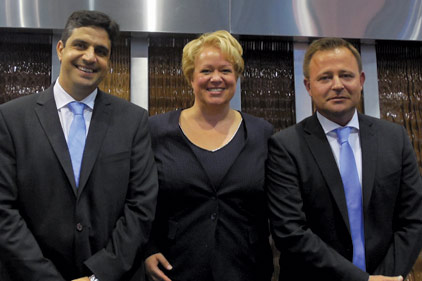
|
As Candy Industry made its way to the Royal Duyvis Wiener booth, Miriam van Dyke, the company’s managing director, was there to greet the team. Still excited from having recently acquired JAF Inox in early March, one of the leading Brazilian manufacturers of cocoa and chocolate equipment, van Dyke proudly pointed to the cascading “wall of chocolate,” which ran continuously 24 hours. As van Dyke explained, it an idea developed by JAF Inox for one of its retail clients and she immediately decided that the concept would be wonderful for the show.
As she explained, “We always aim to peak with our innovations for interpack.” And van Dyke had plenty to show the team at the company’s booth.
“On the cocoa processing side, we’re showing the latest nib roasting and drum roasting equipment. With regards to our grinding line, we’re exhibiting our biggest beater blade possible, which is capable of grinding 6 tons/hour. For our customers, that translates into higher output, less investment.”
Bigger is better is also the theme for the company’s newest cocoa butter press, which features 20 pots. As van Dyke points out, the unit doubles the capacity, turning two tons per hour. At the same time, it still fits into the same footprint as the 10-pot press.
In chocolate processing equipment, the company, in cooperation with its subsidiary Thouet, showcased the latest generation of roll refiners as well as the latest two-shaft dry conche. With regards to ball mill refining/liquid conching, the Lehmann/Wiener subsidiaries were exhibiting the latest in-line chocolate making system.
As van Dyke explained, customers have the option of making chocolate in four different ways.
JAF Inox was also part of the company’s large presence, displaying its broad range of laboratory equipment as well as a new winnower.
“Next year, we will be opening up a new lab at our headquarters in Holland, which will showcase all our technologies,” she adds. When asked how the show was going for her and the company, van Dyke was all smiles.
“We closed on a very big project in West Africa, which translates into complete orders for Duyvis, Lehmann and Weiner.
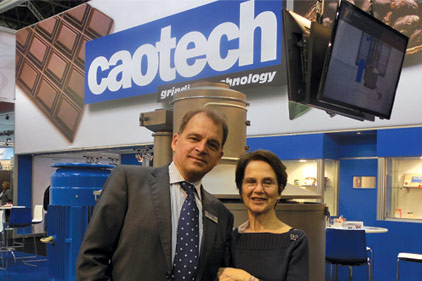
|
That kind of positivism pervaded all of the halls where suppliers to the confectionery industry exhibited. Take for example, Caotech. Olaf Schepel, the company’s sales and marketing manager, pointed to CAO B3000-CHOC DUO line, as an example of flexibility and efficiency that customers are demanding.
Developed for chocolate, compound recipes and fat creams containing a low fat percentage and/or a high content of milk powders, this continuous batch system can produce chocolate or compound at a rate of 1,200 kg per hour.
Moreover, the line’s unique configuration between a horizontal mixer, (water-cooled) grinding shaft, grinding tank and grinding media result in optimum use of grinding/cooling efficiency.
The company has also developed a cocoa regrinding PG 6000 beater blade mill for processing cocoa nibs into cocoa liquor. The unit uses four blades and specially designed bearings to grind the nibs into liquor, which is pumped through a slotted screen at a rate of 6,000 kgs per hour.
“It’s been well-received by multinationals,” Schepel says. Another item that’s attracted plenty of attention is the company’s CWC 5 lab conch. “Many customers are interested in producing small batches of chocolate, using a small ball mill with a lab conch,” he adds.
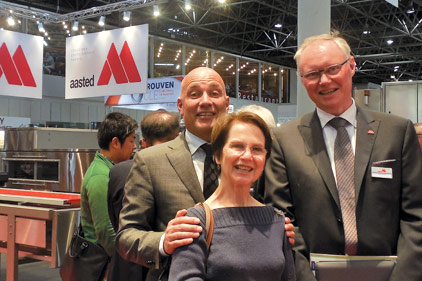
|
Of course, there were also customers looking for complete lines. Aasted, with 825 sq. meters of booth space, was more than happy to oblige, showcasing five lines as well as plenty of stand-alone equipment.
One of the lines attracting plenty of interest was Aasted’s new Nielsen Slab line. Developed to produce high quality granola and nougat bars either with or without inclusions, the line can be easily customized to fit customers’ needs. The new Slab line was displayed together with the company’s new double-headed Alice extruder, an ultrasonic guillotine spreading table and Nielsen enrobing equipment. Together, these combined machines present a complete Aasted bar line solution for granola and nougat bar production.
“We are exhibiting the Nielsen Energy Enrober version on the line as well as the sanitary version of our cooling tunnels,” says Mads Hedstrom, chief sales officer for the company.
There also was a sanitary version of the company’s famed Alice extruder, Alice S, and a complete bakery tunnel oven for the production of cookies, including the Conny Convection oven.
Visitors could also view a new stencil machine dubbed Bertha — “It was Allan Aasted [ceo] that chose the name,” Hedstrom says — as well as a complete moulding line, a robot pick ‘n place packaging system, a two-meter wide chip depositing line with an accompanying cooling tunnel.
Rounding out the lines and mahines displayed, the company was also showing the new developments in Frozen Cone depositors as well as lab equipment.
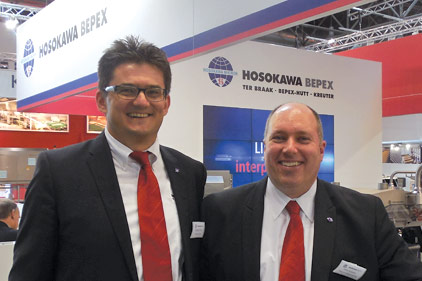
|
Hosokawa Bepex was also exhibiting a complete line at its booth, but with a sanitary twist: the line featured hygienic design from start to finish. With the Ter Braak universal kitchen, the Bepex-Hutt forming and cutting machines, the Kreuter enrobing machine and the cooling tunnel, this system underscored the company’s desire to keep its processing technology one step ahead of the others in the industry.
The company also unveiled its new philosophy summarized by the words: “Create. Integrate. Accelerate.”
As Wolfgang Pförsich, the managing director at Hosokawa Bepex explains, “Create means we’re happy to work together with the customer in creating a solution; Integrate underscores our ability to integrate our knowledge in his process, thereby jointly coming up with a solution; and Accelerate means just that, going faster, and taking operations to a higher level.
All those aspects of Hosokawa Bepex’s have been incorporated into its totally hygienic line. As Pförsich points out, “There have been innovations on the cooking side incorporating the new hygienic design. You can see it in the controls and safety circuits, the process piping, and in the stainless steel.”
The same approach follows for the forming and cutting segment of the line, which features a flex drive system that’s easily accessible. In addition, it’s easy to change the forming unit to an extruding unit, which gives manufacturers more flexibility, Pförsich adds.
With cutting, there’s a higher range of speeds because of the servo motors. In enrobing, the design allows operators to easily change to another color in one hour by simply removing the belt without cutting the wire.
“That an example of an innovation that’s exclusive to Hosokawa,” Pförsich adds.
The cooling tunnel is completely redesigned, the emphasis being on ease of sanitation and maintenance.
The entire line features an automatic control system from Rockwell, which allows personnel to connect it with the production/planning system. Even the forming/extrusion head has an RFID chip embedded into head, which records the number of hours run as well as maintenance info.
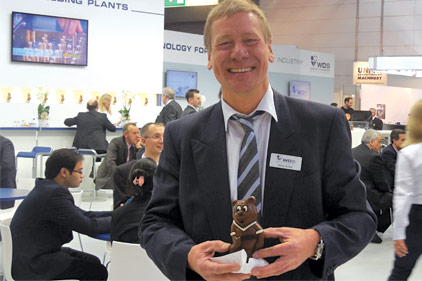
|
Improved hygienics and ease of operation were also the themes at Winkler und Dünnebier Süßwarenmaschinen GmbH’s (WUD) booth. For starters, the company unveiled its SMARTEFFICIENCY concept, which guarantees the best cost-benefit ratio to the customer - from planning to the entire machine life cycle. As Rainer Runkel, managing director explains, “This is achieved by using intelligent production solutions and construction principles based on effectiveness as well as the use of energy-efficient components and optimized processes.”
Its impact could be seen in the innovations presented at interpack, such as the latest generation of the company’s FSC (Flash Shell Cooling) - cold stamping process. To better illustrate the FSC improvements, WUD displayed its hollow chocolate “football bear” to visitors.
Using FSC, it is now possible to form very large and complicated shells precisely in a few seconds. Benefits are, among others, the homogeneous shell thickness of less than 2mm and the opportunity to produce other chocolate products such as bars, tablets and pralines with this machine type, even out of seasonal production.
In conjunction with the FSC process, the company also developed new decorating technology that incorporates a user friendly Form & Design interface, which allows precise movement of the depositor head in a mould.
The Form & Design also enables use of mulitiple colors as well as the ability to copy photographs for use in the design. At the booth, the football bears was made using three different chocolate types and all were individually decorated.
As was the case with many companies at interpack, WDS also introduced an improved “EasyClean” concept.
The EasyClean principle reduces the down time of mass changes and cleaning work to a minimum. For example, a large chocolate depositor, can be removed without tools simply by shifting to a forklift cart. This, of course, minimizes downtime for product changeover.
In addition, interchangeable pump heads can be used in the same frame. One pump head can be changed in 20 minutes, which allows a company to easily change production from say, white to dark chocolate.
The EasyClean principle is also prevalent in the building of the company’s moguls, since they are all constructed using aluminum and stainless steel. The tray transport system uses GPS guidance, which means the trays do not shift or slide, eliminating eliminate broken starch bridges or broken product.
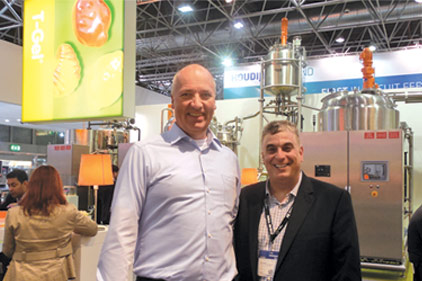
|
Tanis Confectionery also wants to make it easy, especially for manufacturers interested in producing nutraceutical confections, a growing segment of the industry. At the booth, the company was exhibiting a complete jelly line, dubbed T-Gel Nutra, for the production of jellies using active or functional ingredients.
Because accuracy is critical when adding vitamins or other “better-for-you” active ingredients, the T-Nutra line, which also encompasses processing equipment for hard candies and energy/snack bars, delivers high-tech solutions, such as mass-flow dosing and high-shear mixing, to ensure precise results.
Tanis Confectionery’s Team Nutra brings together years of experience and expertise to create beautiful candy using functional ingredients. It also uses that experience and expertise to incorporate the latest processing technology for maximum energy efficiency.

|
At NID, it was all about maximizing flexibility, be it the M3000 S triple hopper mogul, which gives those looking for an entry-level unit much more flexibility. As Grey Young, the company’s ceo, goes on to explain, the unit requires less manpower and enables production of a greater number of products.
It’s attractability proved immediate as Young told the Candy Industry team that the on-floor unit on display was sold, not an everyday occurrence even at a show like interpack.
Ester Faerber, the company’s chairperson and daughter of founder Hans Faerber, spent some time with the Candy Industry team, reminiscing about her father as well as discussing the company’s current and future plans.
“I’m carrying on my father’s tradition,” she says. “He died last June and it’s hard to realize he’s not here anymore. He was a genius, but you have to look forward. And so we’re rebranding the company, doing some structural management changes.
“We’ve moved into a financially secure position; in June, we have $10 million on the order books. We’re seeing many pharmaceutical companies ordering from us during the past few months. They’re intent on producing vitamin gummies. As a result, we’re at capacity building five new moguls.”
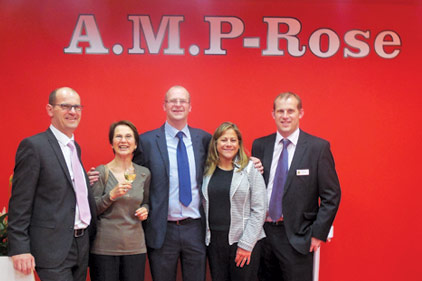
|
There was also a very upbeat note at A.M.P. Rose, which showcased its new booth featuring an upper level for customer meetings. The company unveiled its new chocolate moulding line, the AMP 700. The new line can produce solid chocolate with or without inclusions and is capable of handling 20 moulds per minute at a capacity of up to 8,000 kg/hour.
“It’s a continuous motion, servo-driven, high-end line built for small- and medium-size capacity,” explains Andrew Mann, the company’s sales director. “Built in India, it has an attractive price and it’s drawing a lot of interest.”
“We’re also exhibiting our upgraded batch roller and rope sizer, which features hygienic improvements, making it easier to clean,” he says. “We also exhibiting our 750 cut-and-wrap lollipop machine. That’s a niche market, so you don’t find many people making that kind of machine.”
Mann also pointed to the 7IC twist-and-wrap machine, which features several upgrades, including a servo-driven paper feed system. “It helps the customer save money by saving on wrapping material.”
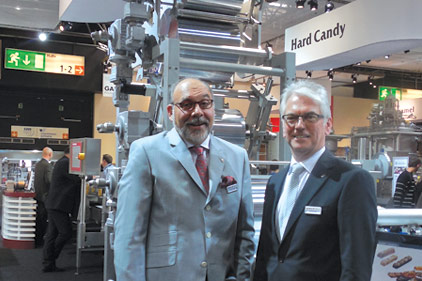
|
Sollich also understands the value of customer involvement. In fact, customer feedback is what drives many of the company’s innovations, says Ralf Schäffer, executive v.p. He cited the development of medium-sized enrobers in 520- , 620- and 820-mm sizes, adding that the company can service confectionery companies as the grow.
Naturally, as was the theme throughout the show, hygienic improvements were also part of the story for Sollich. Schäffer cited the new Conbar line and its new cutting and slitting process, which enables slitting in warm conditions. “The refinement makes it much easier to cut and slit than ever before,” he says.
“We’re also showcasing our new depositor with a volumetric dosing system with a manifold on our biscuit handling system,” Schäffer adds. “Thanks to the volumetric manifold, we can precisely deposit marshmallow, jelly, or fat cream, together with our sandwiching unit, at high speeds. This wasn’t possible with a piston depositor, which is much heavier, thus limiting its movements.”
There are also new developments in the tempering area, Schäffer explains. “First, customers can control of the degree of temper much better. In addition, one can do a changeover from one mass to another much faster.”
There’s also a new rework temperer unit, he adds. Available in 250- and 500-kilogram capacities, the rework temper allows manufacturers to melt and temper chocolate immediately. Moreover, the traceability of all raw material is secured, even with ingredients such as raisins and nuts in the chocolate.
In general, the company has focused on making hygienic and energy consumption improvements across complete lines. “Our goal is to make production efficient without breakages and stoppages as well as reducing cleaning times,” Schäffer says.
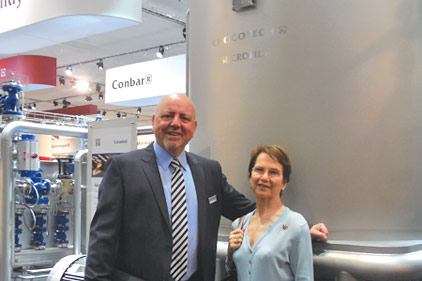
|
At Sollich’s sister company, Chocotech, there’s definitely been an emphasis on energy savings. Debuted at the last interpack, the company’s Ecograv dissolving system can start cooking at 90 solids, which can generate steam savings up to 60 percent, or about €100,000 to €150,000 annually, says Martin McDermott, sales director.
“During the last three years, we’ve sold 10 of these systems for hard candy, chewy candy and fondants,” he says.
McDermott also touted the company’s design innovations as well as its strong service commitment.
“When we install, commission and supply you a continuous system, we ensure it runs continuously,” he says. “Our systems have an inline reclaim that goes in a loop in order to save energy. In addition, in our cooking systems we’ve introduced dynamic cookers with a bigger heat exchange surface. The less steam you use, the longer the cooker can run. That means it takes less time it takes to run a CIP process. So, at intepack, we’re exhibiting our Sucrofilm 2000, the biggest dynamic cooker in the confectionery industry, which has a throughput of up 3,500 kilos per hour.”
Another bigger, or to be more accurate, cleverer item at the Chocotech booth, is the company’s chocolate lentil line. By introducing a new processing step, Chocotech was able to double the capacity of the line, increasing output from 500-600 kilos per hour to 1,200 kilos per hour.
At the booth, visitors were also able to see a complete hard candy forming line from Euromec, Chocotech’s partner for forming equipment.
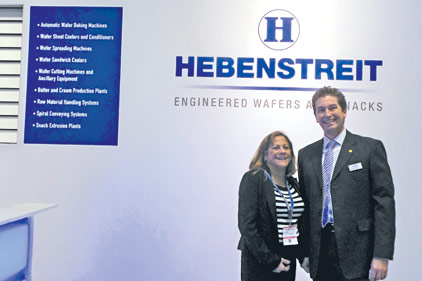
|
With all this talk about hygienic improvement, it wasn’t unusual to see wafer-making equipment supplier Hebenstreit tout their developments in that area as well. In this instance, however, it’s all automatic, says Christian Werner, sale director for the company.
“We have a fully automated laser cleaning system for the baking plates,” he says. Typically, the plates are cleaned once or twice a month. Our fully automated laser system cleans plates top and bottom. On our largest oven, it can be done done in 8 hours, meaning one shift. This truly saves the manufacturer production capacity time.
Werner also revealed another improvement, a larger baking plate. “It’s the next step in wafer production size.During the early 80s, we moved from 500 mm to 700 mm. Today, we now have a 1000-mm baking plate, which provides 40 percent more production capacity.”
At the show, Hebenstreit also displayed a fully automated wafer batter system, produced by Tecon, a company recently acquired. And as an added surprise, Hebenstreit has returned to the snack extrusion business, exhibiting its SE70 units.
“We produced them in the past, so it was easy for us to combine proven technology and improved technology in reintroducing these into the market,” Werner says. “The reaction from customers has been very positive.”
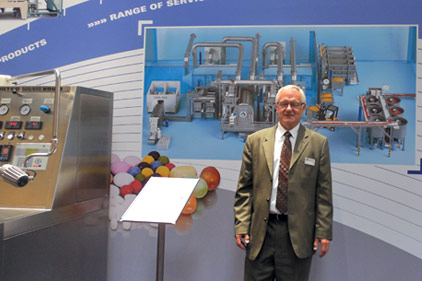
|
Beside showcasing its well-known large volume coater with multiple sophisticated options, Driam presented its new back-to-basics hard sugar coating machine with a maximum capacity of 625 liters. This automated machine features the same customer benefits as all DRIACOTERs are known for, such as fast and uniform coating in a most efficient manner, says Hans Peter Schwendeler, sales manager. This new state-of-the art low budget concept is designed for users with certain expectations for flexibility and automation.
In addition, Driam is also showing its full range of low to large volume, batch and continuous processing machines as well as its capability to handle special and turnkey projects. Also on display was a chewing gum installation, from gum sheet to finished storage, as well as a continuous coater and small lab unit.
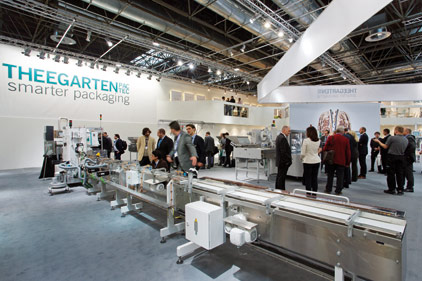
|
At Theegarten-Pactec’s booth, the company showcased 12 exhibits and 20 types of packaging machines. Its HCW4/FPC5 attracted a great deal of attention as this latest generation of machines offers several new features for packaging high-boiled sweets in bottom-fold packaging and further packaging into stick packs. It also includes a technology for smart grouping.
Moreover, Theegarten-Pactec presented another innovation with the updated CWM2. The packaging machine for chocolate products boasts significantly improved ergonomics and accessibility for users compared to its predecessor. Wrapping styles and formats can now be changed in no time at all and can also be easily reproduced.
The MCC is the first continuous-operation machine to offer Vienna-fruit fold wrapping. This increases the maximum operating speed for this type of wrapping from 400 to 800 products per minute.
One would be remiss not to mention the EK, which is fastest wrapping machine designed for hard candies, capable of running 2,300 pieces per minute.
As Managing Director Markus Rustler later revealed, interpack delivered several orders for the company, to the tune almost €5 million. “Many of the concluded project contracts were not anticipated before the fair, making the company’s work for the week all the more gratifying,” he says. “The event exceeded our expectations by a wide margin.”
Indeed, the company concluded its first contact within just three hours of the trade fair getting underway. “The fact that we have started selling machines in Iraq and Jordan again is also a great source of optimism,” Rustler adds.
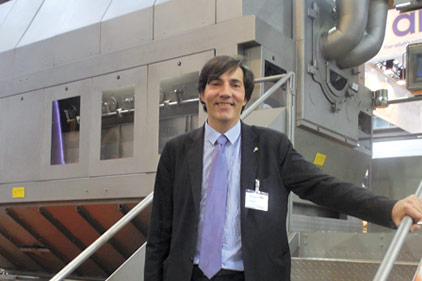
|
For Dumoulin’s Francois Adele, interpack has always been a show where we “Present the best of what we have.” The company’s managing director has also been quick to adapt to changes within the marketplace, such as a demand from smaller and mid-sized confectionery companies for panning equipment that fits their volumes and budgets.
“We’ve revamped a machine that we built in the 1980s, and it has a budget from the 1980s,” Adele says. “Even with complete installation, the unit has an affordable price, even for tiny players.
“You have to remember that sugar coating is a complex process, a long process, boring process, one that can take as long as 10 hours in front of pan. It’s easier to automate bigger quantities. Our unit allows even small players, to coat chocolate or sugar at affordable price.”
Adele stressed that Dumoulin works continuously at improving the panning process, an integral element of the company’s mission.
“One learns how to load, how to clean, how to improve cooking recipes,” he explains. “For example, 10 years ago, it took seven hours to make chewing gum. By tweaking the process, we cut the time to 3.5 hours, with no changes to the machinery.”

|
Showcasing such competency is exactly what Moreno Roncato strived for at Carle-Montanari-OPM’s booth.
“We have six islands showcasing our six product lines, encompassing everything from cocoa and chocolate processing to primary and secondary packaging,” the president and ceo of the company explains.
In the cocoa processing and chocolate preparation area one found a striking interactive video-wall to see a “real size” two-roll pre-refiner HCP 209, a five-roll refiner HFI 518 with MicronSense fineness control and a new energy saving system, the vertical temperer BETA X, with its advanced Smart-Temp System and the ALPHA 6, the new horizontal conche with single shaft.
The “island” for moulding lines featured the Nanoflex 275, the latest intermittent unit featuring a heavy emphasis on hygienic design. The island also displayed a depositor for aerated masses.
In the wrapping “island”, CMFIMA exhibited a VPack2RF, developed to wrap bars in envelope style at high speed and a SM-STICKER, tailored to wrap chocolate pralines in bunch style with aluminum foil with an additional sticker applied on the bottom.
In the primary packaging area, confectioners could view the horizontal flowrapper JT EVO, which, thanks to a special servo-driven, high-speed rotary cross-transfer, is able to perfectly wrap slugs and package on-edge products. As Roncato says, “It’s unique to the industry.”
And finally in the secondary packaging, a pallatizer robot developed by Italian manufacturer, OASI.S was on display.

|
Bühler proved to be another company intent on showing its competency and innovations, which required a a 1,200-sq.-meter area. Many of Bühler’s innovations set trends for entire branches, opening up completely new horizons for the manufacture of confectionery products. For chocolate production, Bühler will introduce new compact solutions for lower capacities, thus also addressing the needs of small and mid-size producers.
Visitors looking for manufacturing systems for cocoa or chocolate can review Bühler’s broad “bean-to-bar” chocolate processing portfolio, which offers excellent process solutions for any and every vision – from single machines to entire production plants.
As for cocoa, Bühler will introduce its latest development in cocoa roasting, the Barth Tornado RSX. A new technology enables higher productivity, efficiency, and flexibility in the roasting process. The shorter cycle times per batch boost throughput of alkalized nibs by an average of 20 percent.
With the PreGrind beater blade mill and FineGrind bead mill, Bühler will also underscore its competence in cocoa grinding. Last but not least, the WinCos control system opens up new dimensions in cocoa plant control.
Bühler also demonstrated its expertise in chocolate processing with its DoMiReCo process (Dosing-Mixing-Refining-Conching) and showcased all of its innovations involving this processing chain. Starting with the stainless steel ShearMix, Bühler demonstrated the latest standards in hygienic design.
The five-roll refiner Finer V, which is also available in stainless steel, is now equipped with a new cooling system and drive concept for reducing energy consumption. A new drive concept for reducing energy consumption was aslo shown for the new Frisse ELK single-shaft conch.

|
There were also several new developments at Confitech’s booth, which Giuseppe Parisi, area manager, was more than thrilled to explain.
“We have a completely new design, all stainless steel and tubular for our machines ,” he says. “They’re easier to access. We also have a new cooling drum that’s a more efficient system for cooling. We’re also displaying a new frame for pulling machine.
“Then there’s a new continuous cooker on display as well as a fast and reliable coater. Our TMX 200 is a heavy-duty continuous cooker that can produce soft candy with inclusion of powder.”
The company has also developed a new patented system for malted milk balls or expanded pulled out candy.
Another company keen on developing innovative processing tools for the marketplace was GEA Food Solution. Its GEA Aquarius FlatFormWrap high-capacity lollipop forming and wrapping machine offers the highest speeds in the market.
Based on more than 20 years’ experience in form wrapping, this new range of machines is designed for continuous production up to 1,000 lollipops per minute. These machines can produce flat, 3-D, fancy as well as spherical lollipops, which enables confectionery producers to start a high-quality and high capacity lollipop line immediately.
Another lollipop innovation that was displayed at the show involved labeling, which adds appeal when merchandising lollipops in a competitive market. As a result, GEA Food Solutions has developed two new labeling options for its high-speed GEA Aquarius BunchWrapper machines: the “label on stick” and an innovative option that inserts a sticker or tattoo inside the wrapping.
The label-on-stick solution results in a label around the lollipop stick with two perfectly flat surfaces that can be used for marketing purposes. The new system combines speed with accuracy, enabling continuous label application right up to 800 lollipops per minute, depending on machine type. At present, no other label-on-stick solution can match this!
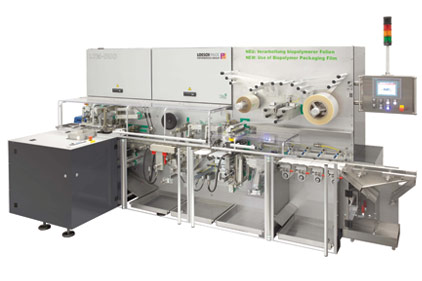
|
Loesch Verpackungstechnik GmbH also unvielded several innovative and leading-edge complete solutions for the confectionery industry, covering chocolate packaging, Napolitan packaging, roll wrapping and flip-top packaging.
When it comes to bar and tablet wrapping solutions, LoeschPack exhibited the latest generation of its LTM-DUO two-stage fold wrapping machine in the corporate design, combined with a flexible display cartoner. From product feeding to display cartoning, the company offers a complete solution from a single source.
On display, the line packs 100-g, flat bars in a vacuum-packed, sealed inner wrap made of aluminum foil from the reel. The outer wrap is formed from a carton processed as a flat, pre-cut blank. The carton folding is traditional with tuck-in flaps, and the seal is closed with hot-setting glue.
In addition to excellent performance of up to 200 bars/minute, the LTM-DUO features great product, size and packaging style flexibility, gentle handling of the product and the use of bio-polymer foil. The refined twin station machine with outstanding overall performance thus sets new standards for packing chocolate bars.

|
After Loeschpack, it was time to visit Corneliano D’Alba, Italy-based Tecno 3, which prides itself on developing technological innovations for the chocolate and confectionery industry. At interpack, it showcased three different pieces of technology addressing specific processing and manufacturing needs.
The MDC-A 250, a continuous doser/mixer for liquid and solid products is used in the production of chocolate and creams, to evenly dose and mix the liquid and solid ingredients that are in the recipes.
Made entirely in AISI 304 stainless steel, the easy-to-move machine, which is mounted on wheels, can be used in a line to continuously feed the refining plants or as a self-contained unit, to be placed in different positions in the production lines. The recipe management and the correct dosage of the ingredients are controlled with a PLC, which also manages all the other parameters, such as the tank temperature, the mixer’s speed and the direction of rotation, the product level, etc.
The Tecno 3 continuous doser-mixer makes it possible to manage even very small quantities of mixture and provides operators with a rapid change of recipe as well as easy, thorough cleaning.
The P10S-CR series system, is a specially designed line for the continuous refining of lipid-based creams in a single step; it represents a significant step forward in process simplification, saving space and energy.
To satisfy the needs of automation and flexibility of the modern production processes, Tecno 3 developed its new ORM robotized station. Mounted on wheels, the unit features an innovative column structure that makes it easy to move the machine between the different work positions. Once it reaches its destination, the station is secured by an anchoring mechanism.
The station is equipped with a multi-camera vision system for tracking products at inlet/outlet. Being fully customizable, the vision system can also perform product compliance monitoring (shape, color, presence/absence of articles, etc.).
For the IMA Group, interest was high, the company reports with many visitors from Europe, Middle East, India, Far East and Central-South America. There were also visitors from emerging countries, who expressed great interest in the new IMA range of machines.
For example, the Universal Machine UM 70 has been developed to close the gap of the industrial machine range between 40- to 90-liter batch size. Typical applications include marzipan and chocolate fillings. For lab and smaller volume applications, there’s the Universal Machine UMC 5 with 2.5-liter batch size and the Universal Machine UM 24 with a 18-liter batch size.
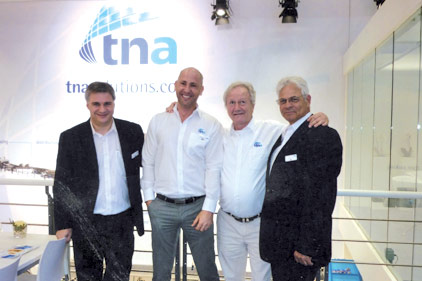
|
tna, known for its high performance, flexible spraying, distribution, seasoning and bagging solutions showcased several confectionery and snack pieces of equipment. Its robag FX 3ci RTJ 180 featured a intelli-weigh 0314 omega multi-head scale, a hyper-detect metal detector and a labeller. This ultra-high speed system offers unmatched throughput rates of 150-180 bags per minute, making it ideal for high volume packaging.
Visitors also saw the company’s latest spraying solutions in action on stand. Two display cabinets showcased the innovative application of oils using tna’s high performance spinning disc spraying technology and variety of options for spray nozzles. For consistent application with minimum waste, the new the company’s intelli-spin 105 spinning disc spraying system achieves an even coating of liquid on the top of products such as confectionery. Easily incorporated into an existing production line, it is ideal for the application of glazes such as sugar, milk, egg or shellac, water, oils, slurries and couverture or tempered chocolate.
tna also highlighted its system automation and SCADA expertise and the ease of integration of its equipment into existing lines via an on stand large re-circulating production line.
And capping off the Candy Industry’s interpack visit was a tour of the Bosch booth. Bosch Packaging Technology combined its decades of experience in bar mass production and packaging to offer one-stop, customized solutions for the production of confectionery, muesli and cereal bars. Part of this technology is the Contiline bar forming system incorporating innovative developments for the forming, cooling, fanning-out, cutting and coating of bars.
Implementation of complete systems for different performance ranges consisted of the following:
- Cooking unit – batch or continuous
- Mixing unit – batch or continuous
- Forming unit
- Mass cooling tunnel
- Longitudinal cutting machine
- Fanning system
- Cross cutting machine/guillotine
- Coating unit with complete tempering and cooling technology
- Decoration unit
- Packaging unit
These Bosch machines are applicable for soft-boiled sugar masses, aerated foam masses as well as different cereal masses (with wheat flakes, granola, nuts, fruit, seeds and manymore). Any kind of device to decorate the bars can be offered.
Well, an exhausted Candy Industry team signs off…till the next interpack. Start planning now!



